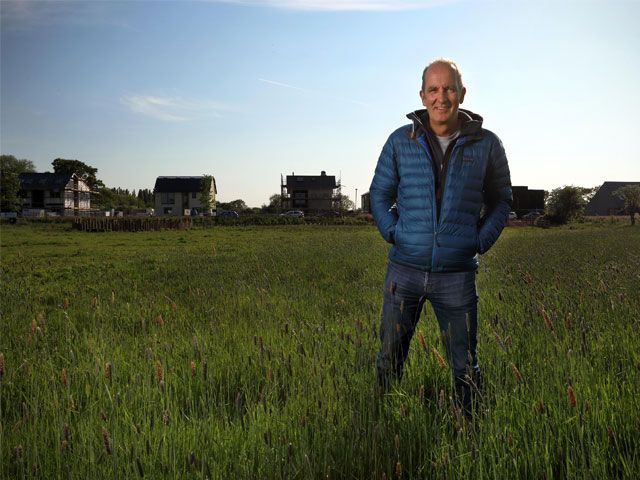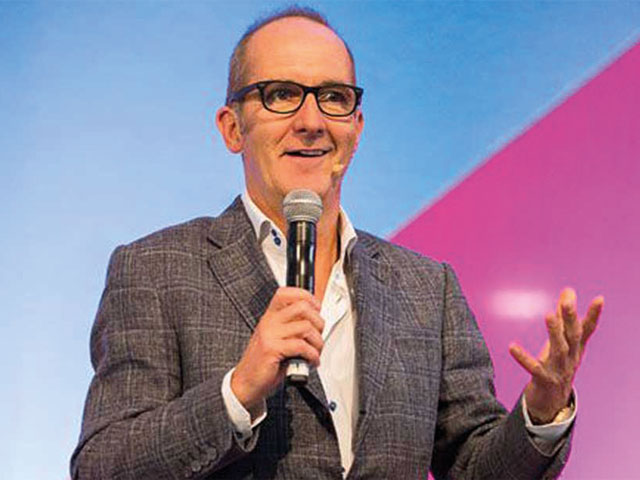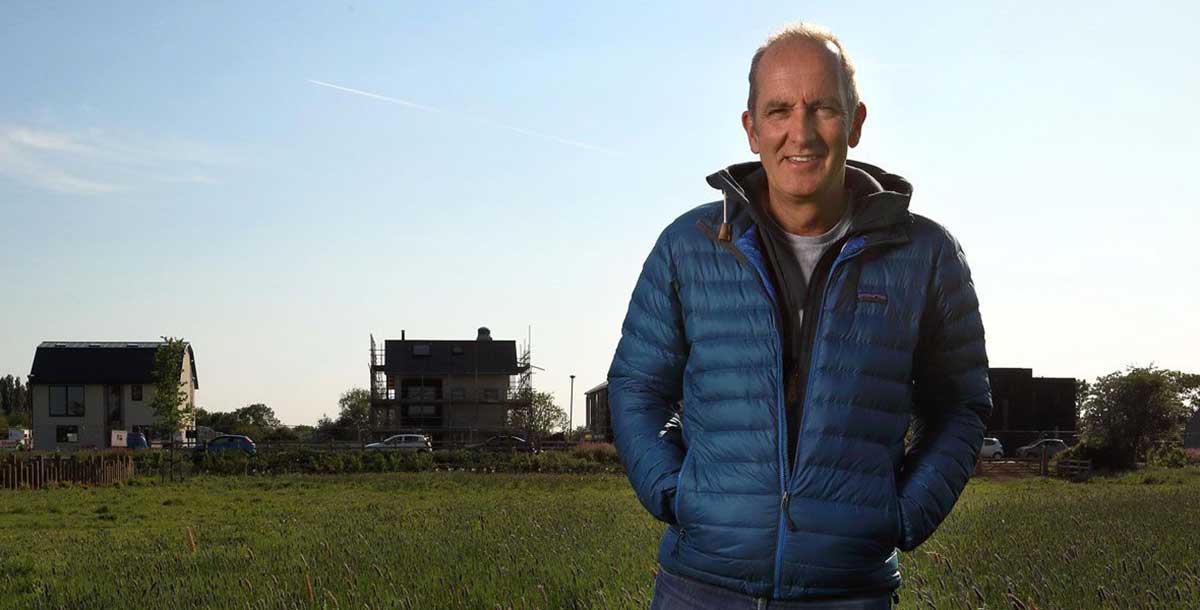Q&A with Kevin McCloud on Grand Designs: The Street
Kevin explains the ideas and inspiration behind the largest self build project in the UK
TV presenter and designer Kevin McCloud reveals the concept and inspiration behind the UK’s biggest self build project. Plus, Kevin talks through his favourite houses from new the brand new series.
Grand Designs: The Street has been an epic five years in the making. Airing on 4th April 2019 at 9pm on Channel 4, this six-part series, presented by Kevin, follows the first 10 pioneering households who are building a brand new street from scratch, on what will ultimately be the UK’s largest self-build project.
Kevin explains the ideas and inspirations behind the brand news series, and reveals his favourite houses featured in the project.

Photo: Fremantle / Boundless
How did Grand Designs: The Street come about?
I went to The Netherlands on a trip with a bunch of leaders of local councils and politicians in 2010 to look at a large self-build town there, Almere, built on reclaimed land near Amsterdam. The Dutch have always stolen a march on us in terms of housing initiatives.
Now, Almere is full of self-built homes, but nine years ago it was already advancing, and I got so excited I had to go and see Channel 4, simply to say ‘it’s amazing what’s happening there, let’s film it’. It was a sort of self-build heaven.
Meanwhile, a small local authority at Bicester, Cherwell District Council, had also been bitten by the Almere bug. In fact, they wanted to replicate Almere and facilitate Britain’s first self-build and custom-build site on a grand scale. They were negotiating with the MOD to buy an old military site as they wanted to see what it would be like if they invited the general public to build their own homes.
It’s this experiment that we’ve been following for the last 5 years. In the process, we’ve witnessed the first 10 pioneering households build a street of very different homes. But it’s just the start. Ultimately there will be thousands of homes, some social housing, some custom-build as well as self-build. I believe it’s a model that could be copied by local authorities up and down the land.
Tell us what we can expect from the new series?
It’s very people based and it’s very observational. We’re following ten households, all of them from different walks of life, with different budgets and they’re probably at the lower end of what you would expect to see on Grand Designs.
These are more accessible projects costing anything from around £200,000 to £400,000, in terms of value, what they’re getting for their money is good architecture and homes that are really tailored to them – all with the lightest of planning!
Our Pioneers are not people with large financial cushions to float on. Building for the first time brings with it a lot of financial, personal and emotional stress – which this series honestly reflects. Relationships get really tested and some fail. I suppose we see a lot of that in Grand Designs, but goodness me I’ve never seen it so repeatedly and so intensely, as in this series.
These very different households all took a big risk but ultimately, I think they’ve been rewarded for this, with brilliant very individual homes and a great, wild-looking street – which is a sort-of test bed for self-build construction techniques which I think is just brilliant. No two homes are the same.
The series highlights how you can achieve your dream home at an affordable budget, but do you think it’s possible to stick to budget and what are your tips to do so?
I think two of the households stuck to budget, but self-build is a huge adventure in expression, in architecture, and in terms of discovering what it is that makes us happy and what we like from our environment.
People talk about going over budget as if it’s this great cardinal sin, whereas, it usually results as a part of the process because people on the way discover things: on the Street one family wanted a dining room on the first floor, in another household Garrie alters the layout to better suit his wife Sue who’s disabled.
I followed one family, Peter and Anita and their teenagers Sam and Lucy, who already lived close to the site. When I first met them, they were wedged into a modest three-bedroom house, which they had clearly outgrown. What this project offered them was the opportunity to put that all right.
For example, it gave them a larger kitchen, open plan living areas as well as cleverly designed spaces for individuals to retreat to do their own thing. Very important with teenagers – and unthinkable in their previous home.
They did all this and stuck to budget but towards the end of the project Peter realised, he could put an extra bedroom in the attic, and with their two kids it just seemed an obvious thing to do.
Suddenly they were discovering what the process of design is. Sometimes building just takes you somewhere that’s far more exciting than you dreamt it would be.
Building their own family home was also a good opportunity for Peter to work with his 18 year old son Sam. A great bonding experience for them both, although in typical teenage fashion, it will take some decades for Sam to reflect on and appreciate this fully.
Financially their story was inspiring, the finished house ended up costing almost half as much as it would cost to buy something similar in the area I think.

Photo: Media 10
Tell us about some of the houses that stand out for you and how they were constructed?
Sometimes when people ask me what my favourite standout projects are, it’s really hard for me to disassociate people and their stories from the building. For example, James – who has great difficulty in finishing his house – his plight, the difficulty of his situation is so touching and so moving that it’s impossible not to love the building, because I so wanted him to succeed.
There’s also the story of Lynn and her house, which again is sort of raw with problems. She experienced a great deal of bad luck and it’s very hard not to feel sorry for her, but she emerges in the series with a very beautiful building. One of my favourite buildings is hers, because it’s so eccentric.
And then there’s Paul and Blanka’s eco home made out of Hemp Shiv, which is, effectively non-hallucinogenic cannabis used as a building material. It’s also a beautifully crafted building and a house jam packed with some very cutting-edge eco-gadgetry which I was fascinated by.
Can you tell us a bit more about the eco house – how that was built and what went into it?
The material, Hempcrete, isn’t common, but it’s certainly earned its pedigree in the UK. It’s a mixture of hemp, which is the stuff they use on the floor of equestrian arenas and is like finely chipped bark and lime.
When mixed with water and lime it forms a kind of eco concrete, the texture of horse poo, which you stuff in-between shuttering. The entire house is built from this stuff – it’s highly insulating, structurally sound, has high thermal mass and locks carbon into a building.
Paul and Blanka slogged and crafted most of this house with their bare hands, occasionally with the help of friends and family. When things got really tough, the street lent a hand too, so it’s been very collaborative at times. It’s a house built from friendship really and has a very cool vibe about it.
Can you tell us about some of the challenges that the pioneers face when building their homes?
Although the planning process was streamlined, they still had to deal with the planners, local council, and building control. This is before they even started building. It was a long list. No one has ever said self-build is easy.
What do you think inspired the pioneers to embark on a self-build project?
I once said to a self-builder, an artist: ‘you are extraordinary people for self-building’. She replied, correcting me: ‘no, we’re ordinary people just doing an extraordinary thing’.
It’s the idea that you take ordinary people who have got this slight glint of ambition and madness in their eye who say, ‘we can build a house, can’t we? How cool would that be?’ And before you know it, they’ve turned themselves into true radicals. I love that!
All of our pioneers – who started out as ordinary householders – have decided to build a home and they’re now all transformed as individuals and hugely empowered. As this town of 1900 homes grows, they’re going to become the go-to gurus of how to build with Hempcrete, or how to deal with the mortgage company. They are the self-build wizards of Graven Hill, at once wise and magical.









